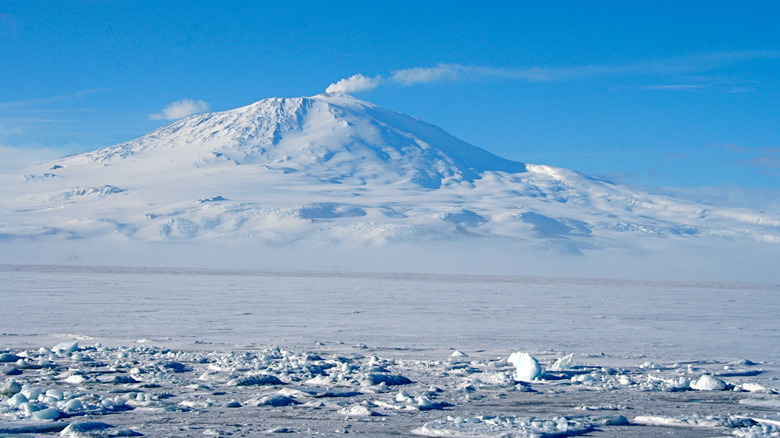The Dangerously Hot Feature You'd Never Expect To Be Present In Antarctica
Antarctica is one of the most extreme environments on the planet, but not always in the ways you'd expect. The southernmost continent famously has the coldest climate on Earth, but it also holds a few surprising records. When you think of a desert, you probably picture sand dunes baked by a blistering sun, but the world's largest desert is actually Antarctica. Here's one even more shocking: the highest concentration of volcanoes on Earth isn't found in Hawaii, the Andes Mountains, or the Mediterranean; it's in Antarctica.
Just because a place is cold doesn't mean it can't host a smoldering volcano. In fact, Iceland has an extremely high rate of volcanic activity that even draws tourism. But, despite the well-known potential for volcanic activity in cold places, it wasn't until recently that scientists realized the South Pole was the center of a massive volcanic region.
The huge ice sheets that cover Antarctica obscure the continent's geography, but a team of researchers was able to use radar signals to survey beneath the ice. Their findings, published by the Geological Society in 2017, tallied a total of 138 volcanoes in the West Antarctic Rift System (WARS), 91 of which had never been identified before. The WARS is roughly 868,730 square miles, but Antarctica as a whole is over 5 million square miles, meaning this survey could be only the tip of the iceberg, or perhaps more appropriately, the tip of the volcano.
Climate change could trigger volcanic chaos around the South Pole
Whenever a volcano is discovered, an obvious question emerges: is this thing going to erupt? When it comes to the volcanoes discovered in Antarctica, scientists aren't entirely sure. The fact that most of these volcanoes are trapped under ice indicates that they haven't erupted in quite some time, but not all kinds of volcanoes that don't erupt are extinct. Determining whether these volcanoes could erupt in the future requires more research.
There are two volcanoes in Antarctica that have been confirmed to be active. One is on Deception Island, just north of the mainland, where a 1967 eruption completely destroyed a Chilean research station and severely damaged a British-run station as well. The second, and more famous, Antarctic volcano is Mount Erebus, which, despite being on the coldest continent, contains a lake of lava in its crater. Erebus also periodically spews steam and rocks.
Antarctica could be in store for a major increase in volcanic activity due to climate change. Melting glacial ice could expose many of the volcanoes that are currently buried. This would also cause isostatic rebound, otherwise known as post-glacial rebound, which is where land that was trapped under an ice sheet rises up in a flurry of tectonic activity after the weight of all that ice is removed. Isostatic rebound could significantly increase the frequency and intensity of volcanic eruptions in Antarctica, accelerating ice loss, threatening research, and more importantly, imperiling life on Earth as a whole.

